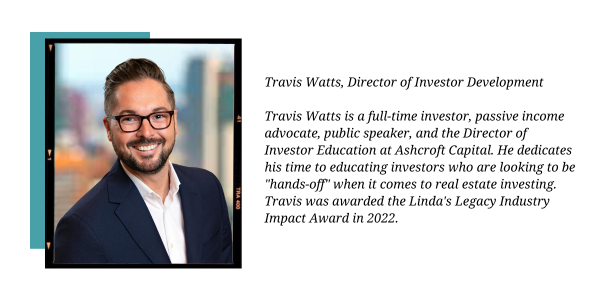December 8, 2022
By: Travis Watts, Director of Investor Development
When I graduated from college and started looking for a job, I started by looking at the companies affiliated with my university, as they hire most of the recent grads. I found the process to be fairly easy. However, because there were endless amounts of applicants, most of the positions were low paying.
Several years later, I worked in the oil and gas industry and realized I had enough passive income from my real estate investments to quit my job and pivot careers. I was interested in learning more about the financial system and wanted to expand my investment knowledge. I went looking for a financial services job that didn’t specifically require a finance degree. The result was nearly the same as my post-college job search. There were a lot of applicants for entry-level to mid-management jobs and most were low paying.
“You get paid in proportion to the difficulty of the problems you solve.”
– Elon Musk
If you send people to Mars or build an electric car company that serves the masses, you may have a good chance of making serious money. These are small niches to operate in, and there are difficult problems to solve for. However, if you look for an entry-level to mid-level job at these types of companies, you’ll likely find a modest to mediocre salary. Let’s examine how this relates to real estate investing.
Question: How many people do you think have an interest in investing in real estate?
30% Let’s estimate that 30 percent of the US population has some level of interest (currently investing or considering investing) in real estate. Now, let’s narrow down to people interested in multifamily real estate, specifically. Whether we’re talking about a duplex or a 600-unit apartment building, what percentage do you think this would be?
10% Let’s assume the numbers drop down to 10 percent. Now, how many people do you think are interested in pre-existing value-add multifamily properties, specifically?
5% Let’s say five percent because some investors may be interested in new development multifamily or other business models. Now let’s examine the interest in only larger units such as a 200+ unit value-add multifamily apartment buildings. How many people do you think would be interested in investing in this this product inside a real estate private placement fund as a limited partner?
3% This percentage continues to narrow as thresholds such as being an accredited investor, or needing $25,000+ to invest limits more of the population.
1% At this point, it is possible that only one percent of the general population may consider investing at this point.
This is one reason why riches are made in the niches. The opportunity to make big money is often found in asset or business that is scarce, in demand, and provides a resource.
Let’s look revert back to Tesla for a minute. Is an electric vehicle scarce? With 250 million cars, SUVs and light-duty trucks on the road in the United States, only one percent are electric. Are electric vehicles in demand? Many electric cars have wait lists that ranges from three months to 24 months at the time of this writing. Prior to the pandemic and war in Ukraine, owners waited 10 weeks. And finally, is an electric vehicle a resource? Absolutely, it is a tool for helping people get from place to place.
Now let’s consider multifamily apartments. Are they scarce? Almost half of Americans, 49 percent say they lack affordable housing in their community. This has grown 10 percent since early 2018. Affordable rents to a wider array of households is needed but several factors including labor, materials, and regulatory restrictions prevent building new multifamily housing. Are multifamily apartments in demand? The national occupancy rate for the last five months sits at 96 percent. Apartment buildings are nearly full and are highly in demand. Are multifamily apartments a resource? Absolutely, given the fact that renters account for 36 percent of U.S. households, apartments are a resource for millions of people.
Ashcroft’s Real Estate Fund
At Ashcroft Capital, we have a proven track record of creating value through renovating, rebranding, and repositioning our multifamily apartment properties in high-demand markets. We buy existing cash flow-positive, high-quality, well-located properties in markets with strong multifamily fundamentals, employment growth, and population growth.
All the properties we acquire have a value-add component which is essentially the ability to reposition the asset through capital improvements and upgrades, renovating the interior units improving operations, decreasing expenses and creating other revenue-generating projects. As we move through our business plans, we are also improving communities and providing a better quality of life for thousands of renters every year.
Real estate funds like the Ashcroft Value-Add Fund 3 (“AVAF3”) offer broader diversification compared to investing in a single deal. Investments are allocated across multiple properties and multiple markets, offering a more balanced portfolio.
The AVAF3 is an open private placement fund for accredited investors interested in diversifying their portfolio(s) into multifamily real estate. The AVAF3 is acquiring multifamily properties throughout the Sunbelt regions (TX, FL, NC and GA) with an anticipated hold period of 5-7 years.
AVAF3 offers both Class A and Class B share types. An investment in Class A shares earns a 9% annualized coupon, generating strong projected cash flows while reducing risk. Upon disposition of a property in the fund portfolio, Class A shares do not participate in the potential equity upside, whereas Class B shares earn a 7% coupon, and have a greater potential return due to participating in the potential equity upside upon the disposition of the properties in the fund.
For additional information, please visit https://info.ashcroftcapital.com/fund or schedule a call with our Investor Relations Team at investorrelations@ashcroftcapital.com.
Download the full article here.



